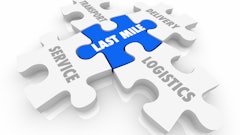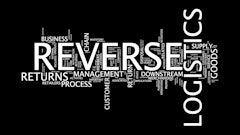Organizations with last mile delivery operations are faced with an increasingly competitive marketplace. They are constantly challenged by customer demands, driver shortages and adverse economic conditions caused by everything from rising fuel prices to changing legislation. These and other circumstances dictate that companies diligently manage their pick-up and delivery (P&D) processes, considering all elements including customer care, driver, vehicle and route management, and service offerings.
To effectively control distribution costs and provide exceptional service to customers, each company should develop a list of best practices and integrate them into their business processes. These processes should be designed to streamline and better manage deliveries, establish and maintain a competitive advantage, and generate new and repeat business.
While best practices will differ between organizations and markets, several apply to any business with delivery operations. This article provides an overview of 10 best practices for establishing, managing and measuring effective last mile P&D programs. It also outlines a framework for lowering costs, eliminating operational complexity and improving customer service.
Best Practices to Streamline Delivery
1. Put a plan in place
Last mile delivery organizations should consider their operations the same way enterprises think about their factory or warehouse operations. Enterprises typically set tightly engineered plans for their production lines and warehouse operations and have specific tools that enable them to benchmark performance against those plans. These plans are typically based on well-researched, granular, labor and activity standards, and they allow manpower and capital assets to be managed for optimal utilization. Delivery organizations need to bring this thinking to the last mile.
2. Implement the technology that fits your business needs
There are many sophisticated logistics technology applications available to help organizations drive delivery efficiencies and boost service. But for companies looking to avoid financial and operating risks, such as high upfront costs to license, install, implement and train users; or for those that want advanced functionality without complex software integration and risks — a hosted, on-demand logistics solution may be the best choice.
A logistics application should offer advanced functionality in a completely integrated solution, providing consistency in reporting and execution, ease of use and visibility into the entire distribution process.
When evaluating technology to assist with logistics management, companies should consider speed, security levels, reliability, as well as a service commitment. Additionally, the payment model needs to be tailored to the needs of each unique business. For example, it could fluctuate with the amount it is used and have variable pricing based on volumes.
3. Analyze and assess information
Once a logistics management solution has been selected and implemented — and a base level of operating history is available — companies should begin to analyze data to assess where their delivery strategies are out of line with their needs or those of their customers, and where cost savings exist and are achievable. A technology solution with integrated business intelligence and reporting modules makes this analysis easy and should allow the information to be accessible by the right people, at the right time.
4. Establish standard operating procedures
A thorough data analysis enables the development of procedures against which performance can be measured. The best running delivery operations are those that establish engineered standards for every aspect of the delivery process. Historical data should be used to identify and create best practices around activities such as load times and service times on particular routes. Regardless of the standards being set, the key is to ensure they are realistic and measurable and that you have designed action plans to improve on the performance of the individuals or the process.
5. Understand qualitative and quantitative constraints in the delivery process
Just as every customer has particular delivery requirements, every business will also have specific ideas with regard to how best to deliver their products. These requirements may be quantitative or qualitative in nature. For example, some companies do not want drivers moving outside of specific geographies, while for others certain items may need special delivery considerations. In developing a delivery plan, all of a company's specific needs must be taken into account. When considering a technology solution to assist with the delivery planning process, ensure it is flexible enough to allow for the typical quantitative constraints as well as the more qualitative business specific requirements and constraints.
6. Manage the driver, not just the vehicle
The key asset in managing any delivery route is the driver. Many companies focus only on the vehicle and not the driver, therefore only addressing part of the activities and costs associated with the P&D process.
For example, while drive times may be separated into morning, afternoon and evening times, routine tasks undertaken by drivers before they are on the road — such as vehicle circle checks and loading activities — may not be factored in. Although these activities are important, they can typically be managed more effectively if companies benchmark and measure actual performance of these tasks in order to get their drivers on the road faster. Secondly, estimates show that between 40 and 60 percent of a driver's time away from a distribution center is not spent driving. In order to ensure that this time is most effectively spent, companies need to carefully examine and monitor what the driver is doing at each stop, measuring driver performance and service times against activity-based standards.
7. Plan around the customer
The concept of “customer is king”' also applies to the P&D business. While every company wants an optimized routing plan, it needs to be balanced to ensure routes and delivery times reflect customer needs and demands. For example, route plans may need to be adjusted to accommodate certain receiver requirements: restaurants that can only receive deliveries at specific times; retailers with tightly coordinated loading dock schedules; or business customers that expect the consistency of 10 a.m. deliveries.
At the same time, consumer expectations are higher than ever, especially when it comes to service. Consumers expect more frequent deliveries of fewer items and are not willing to accept broad delivery windows that keep them tied to their homes for hours. By establishing best practices, businesses can narrow their delivery windows, and in doing so improve their customer service levels.
8. Measure your customer
Measuring customer performance can be valuable as well. Capturing customer history and exceptions, such as dock delays or receiver problems, can highlight delivery problems that are being caused by the customer. With this information, delivery companies can work with their customers to ultimately lower the cost of each delivery and ensure better customer service.
9. Expect the unexpected
Exceptions such as bad weather, traffic jams and unexpected delays are all contributing factors when it comes to on-time delivery. Since even the best made plans can fail, contingencies must be established and delivery organizations must have real-time visibility into exceptions immediately when they occur.
With a high degree of visibility into delivery operations, dispatchers can proactively respond to service disruptions or delays and immediately adjust a driver's schedule accordingly. Customer service reps can resolve customer issues more effectively and, in some instances, customers may then receive notification of pending delays and updated estimated times of arrival.
10. Measure performance against a plan
Once all the factors detailed above have been considered, a company should develop a well-engineered plan to meet their delivery needs. Using detailed reports and business analysis tools, an organization can review its delivery history and assess activities by driver, area customer or any other group to improve planning, deployment and management of its resources.
With an engineered plan in place, organizations can assess planned versus actual load, drive and service times to increase driver productivity and accountability; measure on-time delivery percentages; and determine where schedule and process adjustments can be made to ensure customer requirements are met economically. When businesses measure their operations against engineered standards, they can implement changes to increase asset utilization, improve profitability and ensure appropriate levels of customer service.
Where the Rubber Meets the Road
Implementing technology to help with the management of the delivery process is an important step for any business looking to optimize its delivery systems and differentiate their service. But for those that are serious about positioning for success, the real rewards can be seen when a solid foundation of operational practices is implemented and technology is used to support the achievement of these practices.
While the concept of establishing best practices may sound complex, it does not have to be a lengthy or difficult process. In fact, a company can identify and apply best practices within 45 to 60 days. In order to ensure that these best practices can be achieved, organizations need to choose technology that can support them by being flexible enough to work within their business requirements, easy to implement and easy to use. When best practices become an integral component of an organization's delivery operations, the rewards are clearly visible within a very short period of time.






![Pros To Know 2026 [color]](https://img.sdcexec.com/mindful/acbm/workspaces/default/uploads/2025/08/prostoknow-2026-color.mduFvhpgMk.png?ar=16%3A9&auto=format%2Ccompress&bg=fff&fill-color=fff&fit=fill&h=135&q=70&w=240)








